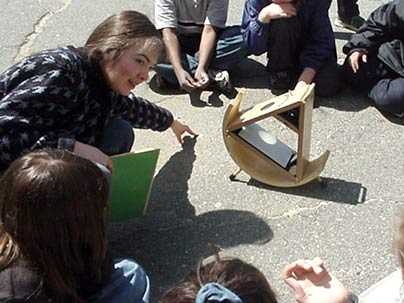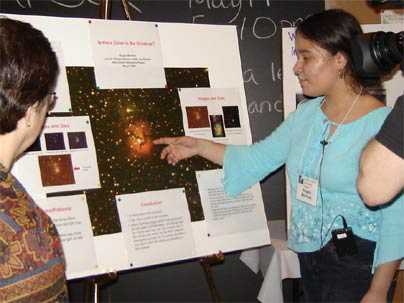An interdisciplinary field with room for creativity, astronomy is the perfect subject to spark a lifelong love of science, says Irene Porro, educational and public outreach scientist in the Kavli Institute for Astrophysics and Space Research. She has just secured a grant from the National Science Foundation to develop a youth astronomy apprenticeship program over the next three years.
"Astronomy is something anyone can do," Porro said. "All they really need to do is walk outside."
The grant is part of a collaborative effort between Porro, Professor of Physics John Belcher, Mary Dussault of the Smithsonian Astrophysical Observatory and Susan M. O'Connor of the Timothy Smith Network of urban community computer technology centers.
The Community Learning Through Youth Astronomy Apprenticeships (YAA) program will be funded by the grant. The program will be open to underserved and underrepresented high-school-age students. The grant will cover training of four YAA fellows who will run an after-school program for up to 120 students. From that program, 25-30 will be selected for summer apprenticeships, where they will earn a stipend of $9 an hour.
The apprenticeships will be carried out with the collaboration of several organizations--in particular, those involved in informal science education--in the Boston area. "We are providing the incentive to have a great summer job and to do something fun and interesting," Porro said.
The apprentices will be selected from a pool of students involved in the current After School Astronomy Project (ASAP) run by the MIT Kavli Institute. ASAP is offered at eight after-school sites in Boston and Cambridge.
The students do their work using the MicroObservatory, a network of educational telescopes that are similar to professional instruments, designed and built by the Science Education Department of the Smithsonian Astrophysical Observatory. Students request images by submitting commands to the telescopes via a web interface. The robotic telescopes take the requested images, which are then e-mailed to the students.
In the spring, students will present at the annual "Astronomy in the City," event, which started in May of this year. Students in grade 6 to 12 attended the program. Next year's event is May 12.
For Porro, the final event exemplifies much of what she hopes the students will gain from the apprenticeship program, as younger students watched older students in awe and were inspired to learn even more. "It is far more powerful than just teaching them string theory," Porro said. "It is so critical to empower these kids."
"The idea is that yes, we need to engage youth by having them practice science in a way that is fun, but most of all meaningful," Porro said. "Yes, we want to spark their interest, but then we need to continue working with them and develop their capacity to do actual science."
The program uses a "project-based" approach to learning, said Porro. This means that students investigate their own questions. Porro told the story of a girl last year whose digital images of galaxies and nebulae were all returned in black and white.
"She asked, 'Is the universe all in black and white?'" Porro said. Rather than hand her the answer, Porro encouraged the girl to do a simple experiment to test her prediction that the universe would have no color.
The girl then took images with the MicroObservatory telescopes, this time using red, blue and green color filters. These filters let respectively only red, blue or green light to be recorded by the detector. Because she obtained images in all three cases, the girl answered her own question by discovering that the universe is, in fact, full of color. "We just gave her the tools," Porro said.
Interested students must attend all of the after-school sessions and go through an application process to demonstrate their level of interest, Porro said. She expects it to be competitive.
As the apprenticeship program takes off, Porro said she hopes the idea will spread to communities and cities beyond Boston. "This is a way to introduce and develop critical skills in these students," Porro said. "It is exciting."
The MIT Kavli Institute was started in 2004 after a $7.5 million gift from the Kavli Foundation dedicated to new studies of the cosmos. The MIT institute was the 10th created by the Kavli Foundation since its founding in December 2000. All focus on neuroscience, cosmology or nanoscience.
A version of this article appeared in MIT Tech Talk on November 8, 2006 (download PDF).







